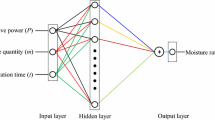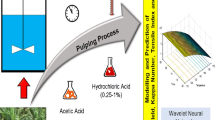Abstract
The drying conditions of Tenera palm nuts was optimized with reference to the cracking efficiency using newly developed drier and modified cracker. The three drying variables considered were drying temperatures (50, 60 and 70 °C), drying periods (18, 21 and 24 h) and age (20, 35 and 50 years) of the palm tree that produced the palm nuts. The cracker performance characteristics were cracking efficiency, the un-cracked percentage and final moisture content. The Box–Behnken rotatable design was adopted to generate seventeen runs of experiment. The experimental data were optimized using response surface methodology (RSM) and Desirability contour plots and compared with Artificial neural network (ANN) model plots. The results show that the optimum drying variables occurred within the neighborhood of drying temperature (60 °C), drying period (21 h) and age (35 year) with corresponding actual, RSM and ANN response values of 98%, 2%, 0% and 10.5%; 97.80%, 1.8%, 0% and 10.52; 97.3%, 2.37%, 0% and 10.72% for cracking efficiency, un-cracked percentage, damage percentage and final moisture content, respectively. The results of the ANOVA show that the quadratic regression modeling equations were significant at p ≤ 0.05 for all responses.








Similar content being viewed by others
References
Ajay More (2019) Global palm oil market 2019: Global Industry Overview by Size, Share, Future Growth, Development, Revenue, Top Key Players Analysis and Growth Factors up to 2024 Published: July 23, 2019 at 12:27 p.m. ET. https://www.360marketupdates.com/enquiry/pre-order-enquiry/13728539.
Ajewole PO (2014) Experimental determination of the rotor speed of a vertical-shaft centrifugal nut cracking machine. Int J Eng Res Sci 2:506–510
Alade EI, Koya OA, Omidiji BV (2020) Development of a modified palm-nut cracker. Agric Eng Int CIGR J 22(1):204–214
Anita OO (2014) Study of impact energy required for effective cracking of dried oil palm nuts. Nigerian J Technol Dev 8(1):23–30
ASABE (2006) American Society of Agricultural Biological Engineers, ASABE Standard S. 351–353. Agricultural Engineers Year Book ASABE, p 345
Babatunde OO, Okoli JO (1988) Investigation into the effect of nut size on the speed needed for cracking palm nut in centrifugal nut cracker. Nigerian J Palm Oil Seeds 9(1):84–88
Bueche FJ, Hecht E (2000) College physics. Schaum’s Outline Series McGraw-Hill eBooks, copyearight act of 1976. United State of America. https://doi.org/10.1036/0072128232
Gbabo A, Gana IM, Amoto MS (2013) Design, fabrication and testing of a millet thresher. Net Journal of Agricultural Science 1(4):100–106
Idowu DI, Tamba J, Sadiku RE, Sofuwa O, Onuoha OJ, Kupolati WK (2016) Design and performance evaluation of a horizontal-shaft palm kernel cracking machine. In: 3rd International conference on African development. (CU-ICAD 2016) pp 337–341
Khurmi RS, Gupta JK (2005) Machine design, S.I Unit Edition, New Delhi, India, pp 1000–1001
Koya OA, Faborode MO (2006) Separation theory for palm kernel and shell mixture on a spinning disc. Biosys Eng 95(3):405–412. https://doi.org/10.1016/j.biosystemseng.2006.07.005
Saw HY, Janaum J, Kumaresan S, Chu CM (2012) Characterization of the physical properties of palm kernel cake. Int J Food Prop 15(3):536–548. https://doi.org/10.1080/10942912.2010.492543
Mohd-Hafiz MH, Abdul-Rashid MS (2011) Oil palm physical and optical characteristics from two different planting materials. Res J Appl Sci Eng Technol 3(9):953–962
Morakinyo TA, Bamgboye AI (2015) Effects of age on some physical properties of oil palm fruitlets. Agric Eng Int CIGR J 17(3):342–352
Morakinyo TA, Bamgboye AI (2016) The optimization of operation parameters of a vertical sterilizer of medium-scale oil palm mill using Taguchi. J Food Process Eng . https://doi.org/10.1111/jpe/12453.Hoboken,NewJersey,USA
Morakinyo TA, Bamgboye AI (2016) Performance characterization and optimization of a synchronized medium-scale of oil palm fruits processing mill. J Food Process Eng. https://doi.org/10.1111/jpe/12523.Hoboken,NewJersey,USA
Morakinyo TA, Bamgboye AI (2016) Comparative study of the chemical properties of palm oil extracted using medium-scale mill and traditional methods in Southwest of Nigeria. Nigerian Food J 34(1):33–44
Morakinyo TA, Bamgboye AI (2019) Some Engineering properties of palm nuts, kernel shell, fibre and woods for effective mill equipment design. Am J Mater Sci Appl 7(1):1–7
Morakinyo TA (2019) Design modifications and performance evaluation of a centrifugal impact palm nuts cracker. In: Proceedings of the obafemi awolowo university, faculty of technology conference 2019, ISSN 2705–3024, pp 167–180
Ndukwu MC, Asoegwu SN (2010) Functional performance of a vertical shaft centrifugal palm nut cracker. Res Agric Eng CIGR 56(2):77–88
Oke PK (2007) Development and Performance Evaluation of Indigenous Palm Kernel Dual Processing Machine. J Eng Appl Sci 2(2):701–705
Olaoye JO, Adekanye TA (2018) Properties influencing cracking and separation of palm nuts in a mechanical cracker cum separator. Croat J Food Sci Technol 10(1):42–50
Omoruyi A, Ugwu KC (2015) Optimization and performance evaluation of palm nut cracking machine. Int J Sci Res 4(7):646–653
Owolarafe OK, Obayopo SO, Adeboye BS, Akintibubo AE (2012) Development of a nut/fibre separator. J Agric Eng Technol 20(2):38–50
Udo SB, Adejuyigbe SB, Ismaila SO, Adisa AF (2015) Performance evaluation of a palm nuts cracking machine. J Nat Sci Eng Technol 14(1):111–116
Umani KC, Olatunji OM, Ekop IE and Akpan GE (2020) Experimental investigation of the effect of rotor speed of a horizontal shaft centrifugal palm nut cracker on optimum whole kernel production and shell particle size. Sci Afr 7(e00238):1–11. https://doi.org/10.1016/j.sciaf.2019.e00238
Verheye W (2010) Growth and production of oil palm. In: Verheye W (ed) Land use, land cover and soil sciences. Encyclopedia of Life Support Systems (EOLSS), UNESCO-EOLSS. E.I
Acknowledgements
The authors acknowledge the enormous contributions of Mr. Ajagbe, O. O., Department of Food Science and Technology and Mr. Kolade, J. E., Department of Chemical Engineering, Faculty of Technology, Obafemi Awolowo University, Ile-Ife, in the construction and evaluation of machine.
Author information
Authors and Affiliations
Corresponding author
Additional information
Publisher's Note
Springer Nature remains neutral with regard to jurisdictional claims in published maps and institutional affiliations.
Supplementary Information
Below is the link to the electronic supplementary material.
Rights and permissions
About this article
Cite this article
Morakinyo, T.A., Olawoye, B., Taiwo, K.A. et al. Modeling of the Cracking Efficiency of Tenera Cultivar Palm Nuts Using Comparative Analysis Between Artificial Neural Network and Response Surface Methodology. Agric Res 11, 267–280 (2022). https://doi.org/10.1007/s40003-021-00555-x
Received:
Accepted:
Published:
Issue Date:
DOI: https://doi.org/10.1007/s40003-021-00555-x




